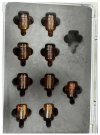Study on the Mechanical Properties of Optimal Water-Containing Basalt Fiber-Reinforced Concrete Under Triaxial Stress Conditions
- PMID: 40731566
- PMCID: PMC12298250
- DOI: 10.3390/ma18143358
Study on the Mechanical Properties of Optimal Water-Containing Basalt Fiber-Reinforced Concrete Under Triaxial Stress Conditions
Abstract
In response to the high-performance requirements of concrete materials under complex triaxial stress states and water-containing environments in marine engineering, this study focuses on water-containing basalt fiber-reinforced concrete (BFRC). Uniaxial compression and splitting tensile tests were conducted on specimens with different fiber contents (0.0%, 0.05%, 0.10%, 0.15%, and 0.20%) to determine the optimal fiber content of 0.1%. The compressive strength of the concrete with this fiber content increased by 13.5% compared to the control group without fiber, reaching 36.90 MPa, while the tensile strength increased by 15.9%, reaching 2.33 MPa. Subsequently, NMR and SEM techniques were employed to analyze the internal pore structure and micro-morphology of BFRC. It was found that an appropriate amount of basalt fiber (content of 0.1%) can optimize the pore structure and form a reticular three-dimensional structure. The pore grading was also improved, with the total porosity decreasing from 7.48% to 7.43%, the proportion of harmless pores increasing from 4.03% to 4.87%, and the proportion of harmful pores decreasing from 1.67% to 1.42%, thereby significantly enhancing the strength of the concrete. Further triaxial compression tests were conducted to investigate the mechanical properties of BFRC under different confining pressures (0, 3, and 6 MPa) and water contents (0%, 1%, 2%, and 4.16%). The results showed that the stress-strain curves primarily underwent four stages: initial crack compaction, elastic deformation, yielding, and failure. In terms of mechanical properties, when the confining pressure increased from 0 MPa to 6 MPa, taking dry sandstone as an example, the peak stress increased by 54.0%, the elastic modulus increased by 15.7%, the peak strain increased by 37.0%, and the peak volumetric strain increased by 80.0%. In contrast, when the water content increased from 0% to 4.16%, taking a confining pressure of 0 MPa as an example, the peak stress decreased by 27.4%, the elastic modulus decreased by 43.2%, the peak strain decreased by 59.3%, and the peak volumetric strain decreased by 106.7%. Regarding failure characteristics, the failure mode shifted from longitudinal splitting under no confining pressure to diagonal shear under confining pressure. Moreover, as the confining pressure increased, the degree of failure became more severe, with more extensive cracks. However, when the water content increased, the failure degree was relatively mild, but it gradually worsened with further increases in water content. Based on the CDP model, a numerical model for simulating the triaxial compression behavior of BFRC was developed. The simulation results exhibited strong consistency with the experimental data, thereby validating the accuracy and applicability of the model.
Keywords: NMR; basalt fiber-reinforced concrete; failure characteristics; mechanical properties; microstructural optimization; triaxial compression.
Conflict of interest statement
The authors declare no conflicts of interest.
Figures
























Similar articles
-
Investigation of the Evolutionary Patterns of Pore Structures and Mechanical Properties During the Hydration Process of Basalt-Fiber-Reinforced Concrete.Materials (Basel). 2025 Jul 8;18(14):3212. doi: 10.3390/ma18143212. Materials (Basel). 2025. PMID: 40731422 Free PMC article.
-
Study on the triaxial compressive properties of alkali activated concrete after freeze-thaw cycles.Sci Rep. 2025 Jul 1;15(1):20517. doi: 10.1038/s41598-025-06337-7. Sci Rep. 2025. PMID: 40596224 Free PMC article.
-
Experimental study on the mechanical properties and deformation failure characteristics of sandstone under graded equal amplitude cyclic loading and unloading.Sci Rep. 2025 Aug 6;15(1):28735. doi: 10.1038/s41598-025-05052-7. Sci Rep. 2025. PMID: 40770237 Free PMC article.
-
Intravenous magnesium sulphate and sotalol for prevention of atrial fibrillation after coronary artery bypass surgery: a systematic review and economic evaluation.Health Technol Assess. 2008 Jun;12(28):iii-iv, ix-95. doi: 10.3310/hta12280. Health Technol Assess. 2008. PMID: 18547499
-
Automated devices for identifying peripheral arterial disease in people with leg ulceration: an evidence synthesis and cost-effectiveness analysis.Health Technol Assess. 2024 Aug;28(37):1-158. doi: 10.3310/TWCG3912. Health Technol Assess. 2024. PMID: 39186036 Free PMC article.
References
-
- Li K. Application Research of High—Precision 3D Seismic Reflection Exploration in Water Area Engineering. Prog. Geophys. 2024;39:1670–1686.
-
- Jing X.X., Shi J.L., Shen T., Zhang J.C., Zhang M.Y. Analysis of the Disaster Prevention and Rescue System and Countermeasures of the Seikan Tunnel in Japan. China Railw. 2020:126–132. doi: 10.19549/j.issn.1001-683x.2020.10.126. - DOI
-
- Bao J.W., Yang Y.L., Xu H., Liu P., Cui Y.F., Song Q. Chloride Salt Erosion Performance of Hybrid Fiber Reinforced Concrete in Marine Environment. Acta Mater. Compos. Sin. 2025:1–15. doi: 10.13801/j.cnki.fhclxb.20250508.002. - DOI
-
- Xia W., Wang G., Ge T., Bai E., Qin L., Zhao J., Liu G. Dynamic compression mechanical behavior and strength prediction modeling of sulfate—Attacked concrete under triaxial static pre—Loading. J. Build. Eng. 2025;100:111784. doi: 10.1016/j.jobe.2025.111784. - DOI
-
- Liu K., Zhao S., Wang D., Yue W., Sun C., Xia Y., Wang Q. Mechanical Properties and Microstructure Damage of Limestone Concrete Under Triaxial Stress. Buildings. 2025;15:1924. doi: 10.3390/buildings15111924. - DOI
Grants and funding
- No.52104222/The National Nature Science Foundation of China
- No.51909224/The National Nature Science Foundation of China
- 2021JLM-48/The Natural Science Basic Research Program of Shaanxi
- 2025JCBMS-511/The Natural Science Basic Research Program of Shaanxi
- 2019JM-182/The Natural Science Basic Research Program of Shaanxi
LinkOut - more resources
Full Text Sources

